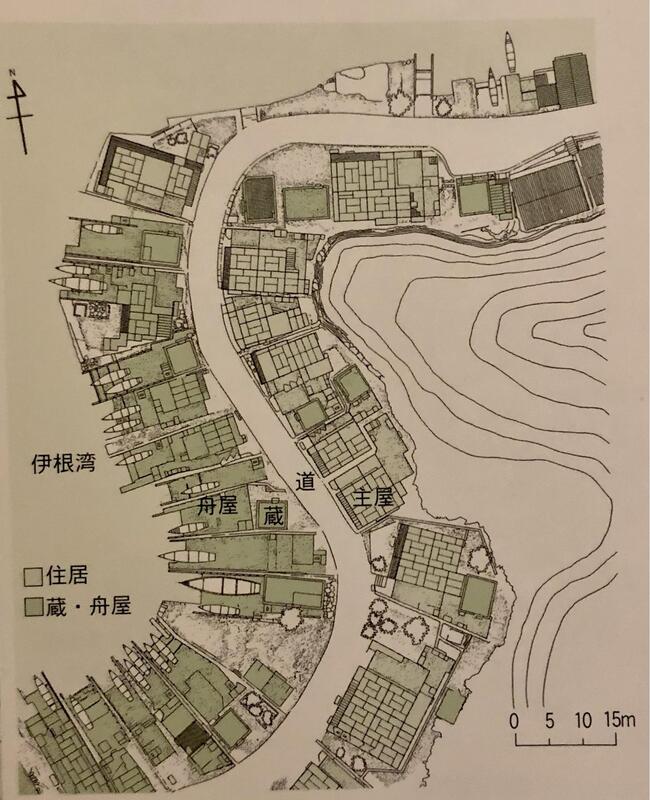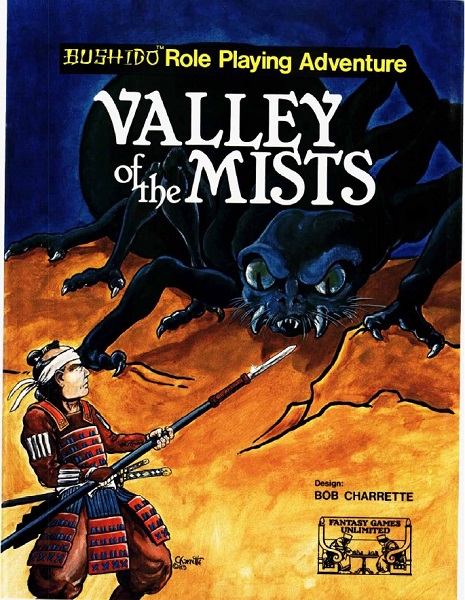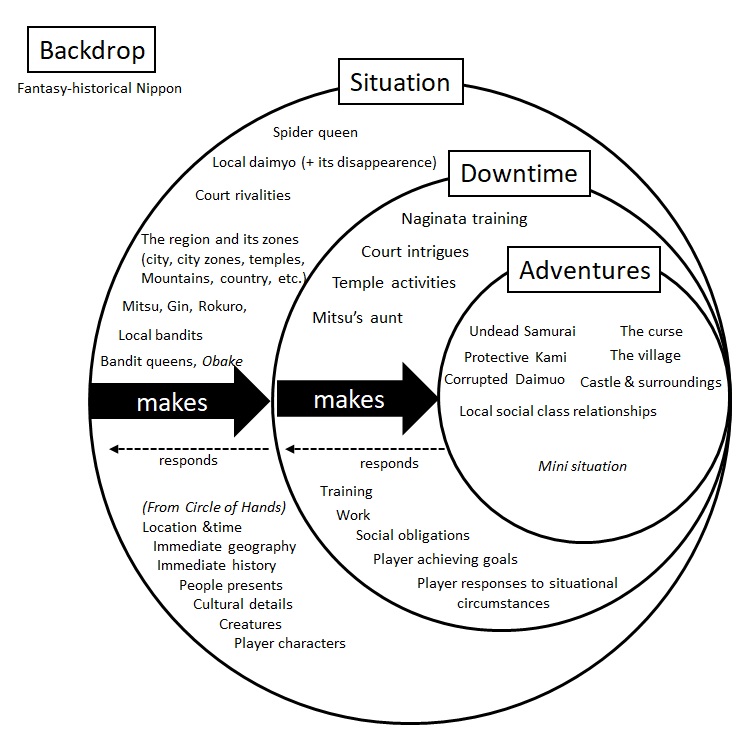Rod, Sean, and I have been playing Bushido for a little bit now: I think we’re at five sessions, each about 2-hours in length.
I’m GMing, though a notable feature of our game is that a lot of “typical GM duties” have been shared out. For one, Rod suggested the historical/geographical background material that informed our set-up: the proliferation of pirates (wokou) in the 13th/14th century and their interconnection with Buddhist temples which were involved in smuggling Buddhist texts and treasures out of China. During this period, whatever centralized Japanese government existed, would often shift among (a) cracking down on the pirates (usually to appease China or Korea) to (b) tacitly supporting them to (c) having them act as de facto official navies. Rod also put together the regional map we’ve been using.
With that material in mind, we went through character creation: Rod made Kageuchi, a Bushi ronin, whose clan had been disolved due to their involvement in piracy (getting caught in one of those political shifts mentioned above); Sean made Isho, a Shugenja, from a family of shipbuilders. I then took that and came up with some NPCs to populate the starting situation: Kageuchi’s cousin and Isho’s father were still involved in piracy, and a delegation of samurai from the regionally dominate Matsuura clan had come to root out and bring to justice these wokou holdouts. Of note: there was a lot of hypocrisy in this, as the Matsuura clan’s own power was very much linked to their (ongoing) practice of piracy.
As things played out, Kageuchi and Isho both agreed to help the Matsuura samurai. I won’t go into all of the details here, but the end result both of Sean and Rod’s choices as well as the reactions of my NPCs (sometimes off-stage) led to the Matsuura party discovering the location of the pirate base and planning to mount an expedition to attack it. Before they could do so, Kageuchi’s cousin, Motokuni, led a preemptive attack on the village with forces made up of pirate rabble, as well as four Kojin (shark men), whom Isho was able to determine were present due to some kind of magical compulsion. Motokuni did not achieve the results he hoped for. Isho’s father defected from the pirates, reached town ahead of Motokuni, and raised the alarm: the Matsuura samurai, along with Kageuchi and Isho, were able to mount a very solid defense.
The battle ended with a duel between Motokuni and Kageuchi on the grounds of Motokuni’s father’s former home (before the clan had been disolved), with Kageuchi slaying his cousin.
That brought us to the end of the session right before our most recent one.
After that, Rod and I had a discussion about how the game was going. One thing we noted was that while Bushi characters seem to have a lot to do and seem to be fun to play in combat, Shugenja don’t start with much in the way of usable/playable/situation-altering magical abilities. The scope of their starting abilities is fairly limited and they also have a low chance of success, even for those limited abilities. We were stretching to find ways for Isho to be able to apply at least a little of his magical powers. The way the system is written, it seems that Shugenja really need to spend a lot of downtime in study, working on skills and spells, in order for them to have access to more potent magic. My initial take on how to prepare and play the game was filtered (mostly consciously) through my understanding of Pendragon: I was looking at it more as my job as GM to come up with some scenario, and then we’d fill up the rest of the characters’ year with some downtime afterwards. However, we came to the conclusion that, for Shugenja, if not necessarily for Bushi, the way to approach the game might be to start with the downtime; get a picture of what that studying looks like on a day to day basis; and let any action/adventure/situation develop out of there (perhaps with making use of the kind of random encounter chart provided with the game). (For what it’s worth, the text in the Gamemaster’s Guidebook points towards a difference between whatever the “current adventure” is and encounters generated via the random tables — i.e., language like: “Encounters rarely occur during the carefully planned portion of scenarios. They generally occur when travelling cross country, whether on the road or in the wilds.”)
After having this discussion and catching Sean up on our thoughts, we decided that we’d resolve the hanging issues from the ongoing situation (there were still pirates at large; still some concern about a mystical threat; still some other things mostly happening off-stage) and then dive into the downtime rules to see about getting Isho trained up from a magic-using perspective.
So at the start of our most recent session, Kageuchi decided that he wanted to get out of Matsuura territory (I can let Rod elaborate on the reasons behind that decision), but before doing so would visit his father — who had taken up vows and joined a Buddhist monastery a few days travels from the village. In terms of my own prepared materials, I did have a good sense of Kageuichi’s father’s character, and some general ideas about the monastery, but wasn’t expecting it to come up this session and so let Rod and Sean know that I’d want to play up until the point where my prep wasn’t feeling solid enough for me — there are too many interesting moving pieces in Bushido for me to want to be adding in too many completely new elements on the fly. I also let them know — which was possibly a spoiler — that there was a good chance that Kageuchi’s father was tied into the ongoing situation more directly than perhaps Rod had been thinking (calling back to the original inspirational idea of the connection between the pirates and the monasteries).
Finally, since they were travelling cross country to the monastery, I decided it would be a good time to try out the random encounter rules — which led to a situation where Kageuchi and Isho made it to the monastery, but shortly after they arrived a band of goblins, hungry for human flesh, showed up. We ended this session with that as the cliff-hanger.
To sum up:
I’m having fun with this game, though it is definitely pushing back against some of my habits and my assumed way to approach this kind of game. The kind of preparation I did for it (creating NPCs whose various motivations/goals put the PCs in a situation that demands action, but where there’s no clear right answer of what that action might be) seemed to fight against, in some ways, the more naturalistic elements of the system (the starting weakness of the Shugenja; the elaborate downtime system; the potentially rich random encounter system — which not only includes encounters with creatures/NPCs but also for natural phenomenon like earthquakes and events like battles). I started thinking of things in terms of playing hot vs. playing cool (from Champions Now) and wondering if this game is not better served by keeping things pretty cool until things build up through those naturalistic parts of the system to the point that the unfolding events demand we “go hot”. Still wondering, though, no conclusion yet…
And I’d also note (again) that I’m enjoying Rod’s role not only as a player but as an active participant in some of the “typical GM” decisions. He’s not co-GMing (in the sense that it’s still me with the authority over all the things the Bushido GM needs to have authority over), but his contributions mean that this isn’t a case of me digesting the historical material and presenting it to them, but rather, we, as a group, are exploring this material together, and are actively bringing it into play through the different instruments the game gives each of us.


8 responses to “Rethinking some of my habits”
My lacklustre brain picked up on the goblins. I noticed the shark men, but in general you have a really cool and complex situation which is basically human.
To me, the goblins don’t quite fit with that. Human bandits, sure.
For my dumb tastes, then, the goblins need to be there for a reason. They need to be part of the story, but I don’t like having a “story”. Anyway, for my tastes, they need to fit in to a mainly human driven plot.
Ignore me, because I’m an idiot. You have a really cool thing going on.
(apologies for the delayed reply; I intended to reply and then forgot and then remembered … then forgot …)
With apologies as well for ‘splaining, bakemono is the “goblin” for the game, taken directly from Japanese mythology. It’s a pretty broad category including vampires, those icky head-dangling-ghosts, short warty stupid humanoids, and (basically) ogres; in fact, it’s pretty similar to the ancient British Isles concepts of the Fae. It or they fit very well into the setting because they typically aggravate whatever human-type problems are happening already.
All this is to say that I think you’d like them in play, because they don’t impose an artificial fantasy-RPG or European expectation where it wouldn’t belong.
These are interesting points regarding the Shugenja. Some classes or character types coming into their own at different points (e.g. D&D magic-users) or under different circumstances (with study time, as here) may require or benefit from a nuanced approach.
Your musings about prep vs. a game’s encounter / content-generating procedures are interesting, too, though I don’t have any insights to add.
I also love how you are exploring the material *together*, as you lay out at the end.
Following my experiences with the game, I have decided that when I play it again, I will insist upon beginning with non-adventure play, for at least a season and possibly a year’s worth of fictional time. For one thing, the improvement is surprisingly generous, and turned my gakusho character from a fumbling little dabbler into a rather solid practitioner. For another, I don’t think there is a trade-off between “adventure” and “ordinary life,” but rather, for this game, that the former make sense only in the context of the latter.
We already discussed this, but I share the same conclusions. I would start with “downtime”, and “adventures” would be sparkles coming from the context created by the various choices, character changes, duties executed and consequences of all that during this downtime.
I’m looking back at my character in our experience with the game here. For my young Samourai woman-in-the-making, choosing between “training my Naginata skill and working as a soldier for the Daimo so I can slay local bandits to push my reputation” vs “training my dancing skill and make a tea ceremony so I can seduce the Daimo’s son and find a place in the court” would lead to two very different “adventures”.
Yes, with this qualifier (as I see it).
The GM also has the job not to be a neutral contributor, but to enthuse about the potential of fantasy-historical Nippon too. There’s a lot of socio-political, ecological, or fantastic content that won’t come into play unless the GM brings it.
Erik told us that he was fascinated, for decades, by the cover image for Valley of the Mists.

It mght have included romanticizing the integrity of “published, official” content, or whatever, but let’s simply honor the fact of a teenager looking at the picture and saying, “samurai! giant spider! cool!”
In which case, everything you wrote is absolutely true, but it may also be integrated with and complementary to such preparatory activity as saying, “and now the giant spider monsters are involved.” In other words, not a trade-off between naturalism and sudden/extravagant content, but a mutual combination which operates off the strengths of both.
The previous discussions Dialing down the fantasy and Situated characters are relevant here. Bushido offers extremely powerful potential to arrive at a group’s desired or emergent profile for the variables described in them.
Thank you for pushing my thoughts a little further. It’s true that what I described (downtime activities) cannot happen in a Vaccuum. Using the same example, my character knew that: there was bandit and Obake in the mountains, that the local daimyo seemed to have disappeared. I also brought a little backstory with my character to be able to define my goals: a young woman Samurai from a wounded Clan, who wanted to show she is able to do things that a man can do. I brought that backstory and goals with me, and it influenced a lot what I wanted to do as downtime activities.
Here is a Diagram inspired by this previous discussion Situation: case study
It’s not exactly the same diagram. This one shows which part of the game provides context for the other.
I’ve taken Situational elements as described in Circle of Hands. This provides the context for both Downtime activities and “adventures”. I’ve used the elements from our own game with Erik as examples. The series of posts starts here: https://adeptplay.com/2022/02/06/keizoku-wa-chikara-nari/
I thought Erik was really good at providing the situational context in our own game, and at exposing the sociopolitical and geographical details through the use of map and downtime activities.
He provided an interesting hex map with local clans locations and local terrains.
Starting from this, we had the context for whatever we wanted to do as downtime activities. I found the procedures to be really good, with a choice for how to get money so you can train, but including social obligations that can intrude.
The adventure works like a mini-situation. It worked very well for use to play it with Circle of Hand as a model ie. like a “venture”. A small region with social class relationship and obligations, an exploration of the lay of the geographical and social land, and its own mini-conflicts and supernatural entities and their influences.
I think the “adventure” could also happen in the geographical location where the downtimes activities happen – I could picture an “venture” in the local Court, with its own intrigues and fantasy elements. Then back to the downtimes procedures. Maybe it’s relevant to note that the two “phases” are fictionally embedded, although I treat them separately because Downtime has specific procedures. But the choices and consequences made during this adventure has a direct impact on the situation and thus, in the direct circumstances that the players evaluates to choose their downtime activities.
(here’s the diagram Greg mentioned)
